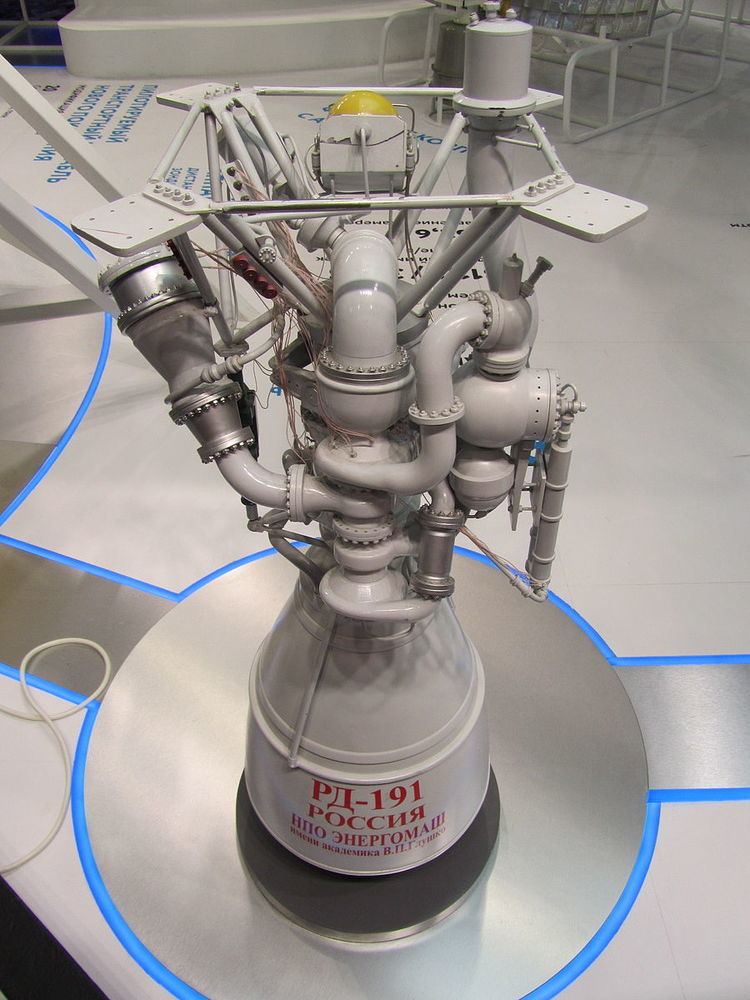Country of origin Russia | Date 2001 Application Main engine | |
 | ||
Manufacturer NPO Energomash / Proton-PM (in transition) | ||
The RD-191 is a high performance single-combustion chamber rocket engine, developed in Russia. It is derived from the RD-170 originally used in the Energia launcher.
Contents
The RD-191 is fueled by a kerosene / LOX mixture and uses an oxygen-rich staged combustion cycle.
Design
Burn ignition is provided by a chemical method, by feeding into the combustion chamber special starting fuel which is self-igniting on contact with liquid oxygen. The engine is capable of throttling down to 30% of nominal thrust; the design also allows for a short-duration enhanced thrust (up to 105% of nominal level) in emergency situations. A Cardan suspension provides for yaw and pitch controls by gimballed thrust deflection up to 8 degrees.
A modern design, the engine incorporates sensors monitoring burn conditions. The measurements are used for telemetry and an emergency protection system.
The engine fulfills two additional functions, heating helium gas for pressurization of propellant tanks and generating hydraulic power for hydraulic actuators to deflect the nozzle and aerodynamic rudders.
Development
On September 5, 2008, the creator of the engine, NPO Energomash, reported that the engine has completed the full cycle of development and burn tests and is ready for manufacturing and delivery. The primary launch vehicle utilizing this engine is the Angara rocket, currently being developed.
As of 2010, the engine has passed all development phases and its nine prototypes have accumulated over 23,000 seconds in 105 firing tests, with one of them reaching the maximum running time of 3,635 seconds in 12 tests. Currently, interdepartmental tests are under way and manufacturing of the engines for flight development tests has started. The flight tests will begin with a launch of the Angara-1.2 light-class rocket, and then of the Angara-A5 heavy launcher. Despite problems with funding, work on the RD-191 engine is in line with the Angara rocket family's master schedule.
RD-151
A version of the RD-191 with thrust reduced to 170 tonnes, called RD-151, was fire-tested on July 30, 2009. The first flight test of this engine was conducted on August 25, 2009 as part of the first launch of South Korean Naro-1 rocket.
RD-181
The RD-181 is based on the RD-191 and is adapted for integration on the Antares rocket. While the RD-193 was designed as a close replacement for the NK-33, on December 17, 2014, Orbital Sciences announced that it would use the NPO Energomash RD-181 on the version 2 Antares launch vehicle and had contracted directly with NPO Energomash for up to 20 RD-181 engines. Two engines will be used on the first stage of each Antares, which is currently used to carry cargo to the International Space Station under contract to NASA. While Russian press had stated that the contract was valued at 1 Billion USD with options, on January 26, 2015, Orbital stated that even when exercising all the options the contract was less than that amount, and that the initial contractual commitment was significantly less than that. Orbital ATK on February 19, 2015, said that its revamped Antares rocket featuring a new main engine would make its first launch in March 2016. On May 29, 2015, Orbital stated that the new engines had successfully conducted seven certification firings and all went as expected. It also stated that the first two flight models were doing its final tests and would be delivered to Orbital in early July.
The two RD-181s have 440 kilonewtons (100,000 lbf) more thrust than the paired AJ-26 engines used on the first generation Antares. Orbital plans to modify the core stage to accommodate the increased performance, and then to finish up its cargo contract commitment to NASA for delivering a total of 20,000 kilograms (44,000 lb) of cargo in only four additional flights, rather than the five more that would have been required with the AJ-26/Antares I combination.
RD-193
In April 2013, it was announced that a further derivation, the RD-193, had completed testing. This version is lighter and shorter, designed for use on the light-launcher Soyuz-2.1v when the inventory of surplus NK-33 engines is exhausted.
